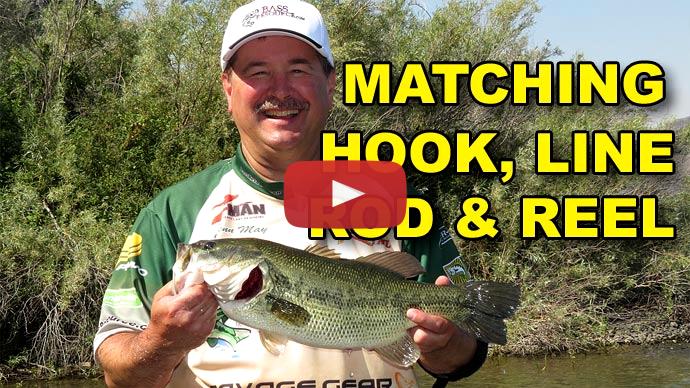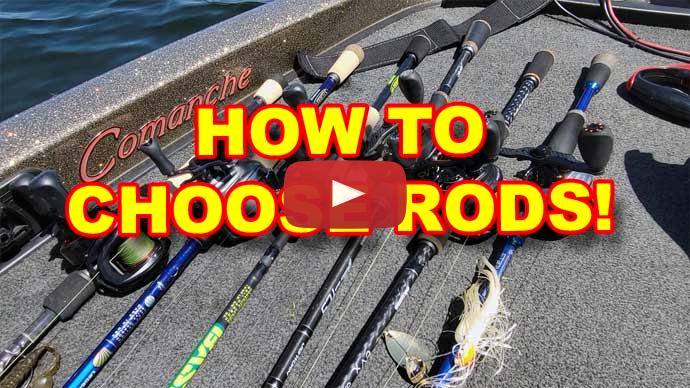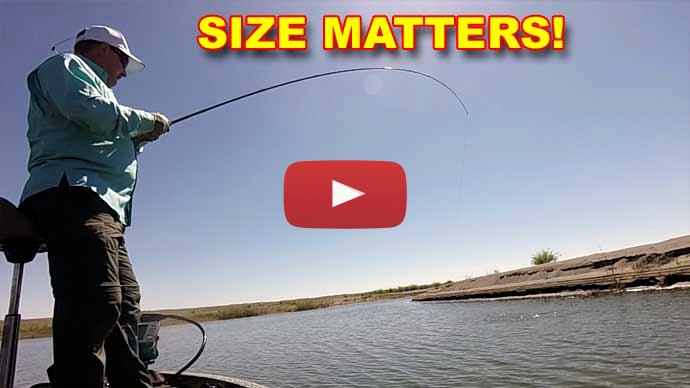You know, when people are talking about fishing rods, they often talk about the power and the action of the rod. Often as those two different terms can be used interchangeably, like they're the same thing. Well, they're not. They are two distinct different things that explain the characteristics of the rod and knowing what those are will help you select the right rod for the fishing conditions that you're fishing and will enable you to catch more fish. So let's kind of dive right into it about the definitions first, and then we're going to talk about how that relates to the different types of fishing techniques, and lures, and lines, and all that stuff. Right?
So first of all, let's define it. The action of the rod, action refers to how long it takes for the rod tip, once it's under load, to come back to its full straight position. Meaning, the shorter the distance it has, the faster the action it is. So think about speed. How short of a time does it take or how long of a time does it take for it to spring back to its natural state, just a straight rod. So there's a couple of different ways that it's defined from the shortest amount of time, which would be extra fast. Then there's fast, moderate, and then slow. Slow is on the other end of the spectrum. Slow would be a rod that can bend the entire length of the rod, almost all the way down to the handle. So because it's bent an awful lot through the whole length of it, it takes a longer amount of time for it to come back to its resting state once the load is removed. Hence, it's slow, right? And then in between, the moderate and the fast action are the two incremental steps between it and extra fast. Extra fast, meaning just the tip of the rod, just the short amount of the rod actually bends and, therefore, it has the least amount of travel back to its straight position. So it's extra fast, okay? All right, I got that defined.
Power, on the other hand, is the resistance to that bend, to that force to bend it, how much force it takes actually, or the resistance it takes to bend the rod. And that's determined by the taper of the rod and the wall thickness of the rod. Power can be where a rod takes a lot of effort to move, and that would be an extra heavy, sometimes referred to as heavy heavy by some rod manufacturers, but extra heavy on one end of the scale, which means it doesn't flex very much at all to the other end of it, which is ultralight. So the whole spectrum of it we'll have from ultralight to medium. Medium heavy, heavy, and then extra heavy or sometimes referred to as heavy heavy. Extra heavy and heavy heavy are interchangeable, those are the same thing. So that's your spectrum in terms of how much force or power it takes to bend the rod.
So, now, that we have those figured out, you would think it'd be easy for you to compare a medium heavy fast-action rod, let's just say a 7'1", medium heavy extra fast rod or medium heavy, let's just say medium heavy fast-action rod. You would think it'd be easy to compare that across different manufacturers. No. Oh, do I ever wish it would be that way? It's not. There aren't any real set standards in the industry in terms of these definitions. It's one-rod manufacturer's extra heavy might be another rod manufacturer's heavy, for example. Now it's not super widespread. So for example, extra fast might not be a moderate in another brand. It's not that crazy. But you can kind of think of it in terms of, like, clothing. Clothing sometimes, yeah, you know, let's just say you wear an extra large shirt. Well, you can't just always go out and get an extra large shirt all the time because they don't always quite fit you right. Sometimes they're a bit too loose, or they're a bit too snug, or the sleeves on them are a bit too long or too short. So you have to try them on. You'll be in the same range. Like, you're not going to put on an extra large shirt and it's going to suddenly become a medium, right? But you still have to try it on because there's going to be variances from one brand to another. And that's what I'm talking about here with the rods.
You're not gonna get a set standard, like, you would say, 35 psi in a tire is 35 psi and there's no variance, even if it's different manufacturers. It's gonna vary from rod manufacturer to rod manufacturer just slightly. So a medium power or a medium heavy power is a little bit different from one rod manufacturer to another. Same with a fast, extra fast tip, those type of things, they're gonna vary just a little bit. So this is why you need to try them out and test them to see if it fits your style of fishing, which is another variable. Some people like a little bit stouter rod, others don't and so on. So what rod manufacturers have done to try to combat that is they'll print on the side the blank, like, a range of pound test line and a range of weight for the lures to give you an idea of what it's best used. And some might even go to the extent of saying, "Hey, this is great for a drop shot rod. This is a good crankbait rod," something like that. They'll actually put the technique on the side to give you an idea of what they feel it's best used for. Doesn't mean that you have to do that and you can go outside the norm. If the rod says it's good for a 1/4-ounce to 1/2-ounce lures, you can use an 1/8-ounce lure or 5/8-ounce lure and you'll be okay. The rod police aren't going to come and take you away. So there aren't any hard rules in here, but there are guidance, guides, right? Just to give you an idea of what it can be used for. So that is helpful when you're comparing rods or you're not exactly sure what rod to get, especially, if you're thinking about getting a rod for a specific technique. Those guidelines can help you in that.
So with that out of the way, let's talk about that though, right? So let's figure out what are the best rod types, or the actions, or powers to use for the different types of lures, and conditions, and lines, and things like that that you're gonna use when you're bass fishing, specifically for bass fishing. So the best way to do that is really to look at the actions. That has more relevance than the power, we'll get to that in a second. But the actions are really what is gonna drive your decision on which rod to use. Let's start all the way with the extra fast rod, which again, that has very little flex. The tip just bends, just the upper portion of the rod bends and it comes back to the resting position very quickly. The nice thing about that is that it's super, super sensitive, right? The rod isn't gonna absorb the sensitivity or any movement by flexing. It's gonna vibrate all the way down that rod to your hand. You're gonna feel every little thing. I mean, you're gonna feel the fish breathe on your lure. It's super sensitive, which is great. It also takes a very little flex before the power of the rod kicks in. And so the power of that rod is really gonna be used a lot more in a rod with an extra fast tip. That's great.
You can use that for, say for example, you're flipping and pitching into heavy cover where you need to turn that fish around. First of all, you need to feel the bite. And sometimes it's difficult because you can't see the fish when you're throwing in that stuff. So you really need to feel it. You typically throw in a jig or a Texas rig bait, something like that. And once you feel that bite, which sometimes can be subtle, you can set the hook and get into play right away, turn that fish towards you, and out of that cover so he doesn't have a chance to wrap up around whatever it is you're throwing into, and use that as leverage to get free. So great situation for that. Also, for, like, punching into heavy mats of vegetation where the lure punches through this thick amount of matted vegetation, and the bite is subtle, and you've got to get that fish up and out of that stuff before he can get tangled in it. That's extra fast tip is really good for that. The downside, of course, there's always trade-offs, and an extra fast tip doesn't have much play in it. Meaning, when the fish gets hooked, and he lunges and surges, and you're playing him back to the boat or to the bank if you're fishing for the bank, that fish can make a little bit bigger hole where the hook is in, and also the line of the rod isn't gonna surge and go with the fish as he surges. So you're going to at times get extra play in the line when the fish suddenly lunges back or jumps in the air, that rod may not have enough flex in it to keep him pinned, and you may end up losing the fish. So, there's some trade-offs in that. It's not great for fighting a fish out in open water. That's an extra fast tip. Isn't gonna do you any favors there.
So that's why you might wanna move to a fast tip, a fast action rod. A fast action rod still has sensitivity to it, not quite as much as extra fast, but it's not that much of a downgrade. So you still have sensitivity to it, but now you've got this flex in it, which does several things. First of all, it does help keep a fish pinned when you're fighting them back to the boat, and it absorbs some of that impact of the fish fighting, and will keep tension on the line, and, therefore, it'll help keep the fish pinned. And, also, when you set the hook, you're not setting it quite as hard so you don't rip a hole in his face. You know, you actually embed the hook into the fish and keep them that way. Also, with the flex of a fast action rod, it aids in casting. That rod will load up and flex, and when you cast, you're using actually the rod to fling it out there like a spring, fling that lure out there, which again, an extra fast rod, it isn't very good at that. That's why extra fast rods are good for flipping and pitching when you're not really relying on the bend of the rod to cast the rod per se. It doesn't make a very good rod for casting far distances because that tip doesn't flex much, but a fast action rod does. So it's really good for a variety of different techniques. You can use a fast action rod for casting crankbaits, and for casting spinner baits, and jigs, and worms, and buzz baits, and topwaters. A fast action rod is pretty much the generic, that's kind of what you have in the majority of the rods from a bass angler's arsenal perspective. Most of the rods are going to be fast action. Except for, of course, the flipping, and pitching, and the punching rods, like I just mentioned. The ones where you need a real stout rod.
Going a little bit further into moderate action, that rod has a lot of bend in it, a lot of give in it. Moderate action is something that I would recommend using for lures that have treble hooks in them. Because treble hooks or small hooks, like a 1/0 or a size 1, treble hooks have a small bite to them. They're usually a finer wire, so they're not as stout. So those hooks are easy to rip out of a fish's face. They're easy to bend a little bit when the fish is fighting. If you've got a stout rod or a line that doesn't give, you don't have very good drag, it's easier for the fish to pull free unless you have a moderate action rod. Moderate, gives a little best because it's like a big spring and it gives, every time that fish surges, it goes with the fish. The fish comes back, it comes back with the fish. It really keeps that tension on the line without putting a lot of pressure on the hooks itself. You're putting more of it on the rod, letting the rod do the job of absorbing that impact more so than the treble hooks. The nice thing, also, about having a rod like that is, you can cast a light lure a long way. So light crankbaits, small crankbaits, topwaters like popars and chuggers that you need to throw a long way, perhaps even into the wind, a moderate action rod will do the job for you. The nice thing, also, about treble hook lures is fish when they grab them, they pretty much set the hook themselves. So you don't need that power to set the hook and drive a hook deep into a fish's jaw, whereas if you're flipping and pitching with a stout 5/0 thick hook or flipping hook, that's where that extra fast rod will do that for you. But it won't so much if you're using a moderate action rod, you're not going to be able to set the hook very well because it's kind of like a rubber band. It doesn't have that kind of power to it. So you have to understand about when to use these different actions for the different types of lures and cover that you're throwing. The thicker the cover, the thicker the hook, the bigger the hook, the faster the action rod. That's kind of the way that goes there.
I would not use a slow action rod for bass fishing. It just doesn't have enough power at all. It has enough strength in it to really set the hook in a fish's mouth for a bass. A bass is real bony. His mouth is bony. It's got a lot of cartilage in it. You need some power to set the hook and keep the hook pinned. A slow action rod just doesn't have enough to be able to do that. It's better suited for, like, trout, or crappie, or something like that bream, where you can easily rip the hook out of the fish's mouth. So slow action rods don't really come into play for bass fishing. Now, let's talk about power a little bit. Power, again, with bass fishing, ultralight is not necessarily...that's not a normal power rod you'd use for bass fishing. Now, if you got a pond that's got a little fish, it's fun to catch them with ultralight rods because they feel like they're 5-pounders. I mean, it's hard to set the hook in them and the fish just moves a little bit. He just bends and pulls on the rod. You're usually using 2-pound line, 4-pound test line, something like that, and you can have yourself a blast. But for normal everyday bass fishing, ultralight rods, not so much. So you want to move up a little bit in the spectrum. So a medium power still is a bit too light. You would think maybe let's use medium for crankbaits. If you use a medium power, moderate action rod, that is still too light for most bass fishing applications.
If I were throwing crankbait rods, I'd be using, say, a medium heavy, moderate action rod. That's a good combination for most crankbaits. You can do medium, moderate if you've got crankbaits that got little teeny hooks on them, small crankbaits like that that have a small bite. Then, okay, a medium power moderate action rod would do the job. But a medium heavy moderate action rod covers most of the spectrum of most crankbaits and topwaters. It also makes actually a good Senko rod too. You know, lighter lures, light lures like Senko's. Things like that, you can cast them really far and you still have some backbone to set the hook. Typically with Senkos and soft plastic stick baits, flukes and the like, you're using maybe a 2/0 hook, nothing any bigger than that. So you've got enough power to set the hook and keep them pinned. So moving up the spectrum, a medium heavy power rod is, typically...that's like your bread and butter for most bass fishing applications. You're just changing the action at that point. So I hope that helps explain a lot of it, and helps you kind of figure out what to do. Hit me up, leave some questions down here on the bottom if you're not sure, and I'll jump on them, and I'll answer them for you.



